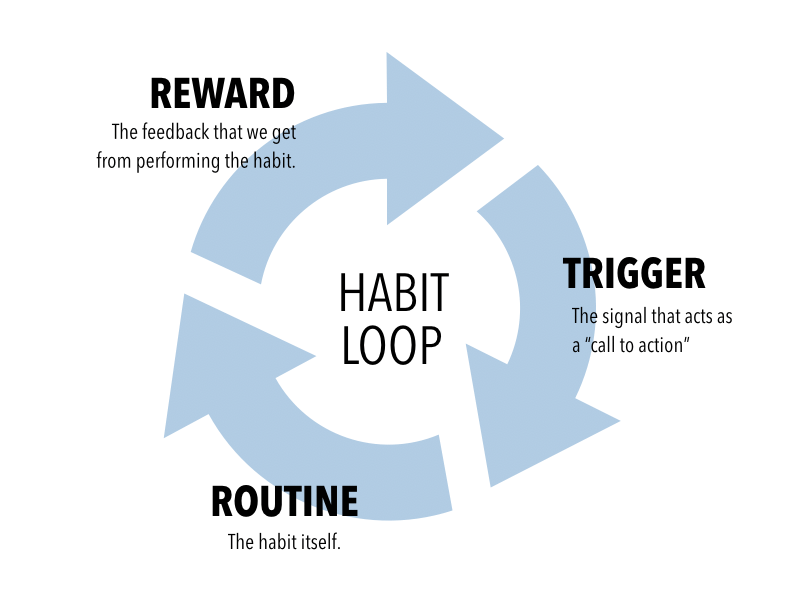The holy grail for every brand launching a new product is to create a customer habit. Why? Because research says the number one reason people don’t adopt new products is because they don’t create a new habit to go along with it.
They use your product, they love it, but then they just forget to keep using it. A deceptively simple reason for a new product to fail, but the most common.
How Habits Work: The Habit Loop
In the 1990s, researchers at the Massachusetts Institute of Technology (MIT) decoded the structure of habits in a series of neuroscience studies. The so-called “Habit Loop” (a term coined by author Charles Duhigg in his book, "The Power of Habit") describes the neurological patterns that govern routines. The loop consists of three parts:
- The trigger (or cue): These are signals to our unconscious minds that it’s time to perform our habit.
- The routine: This is the habit itself.
- The reward: This is the physical or psychological payoff you get from performing your habit.

Source: Created by the author
5 Types of Habit Triggers + a Bonus
If you want to create a new customer habit, you have to pay a lot of attention to the Triggers that kick off a habit. Without these external or internal motivators, people just forget to open your app, floss their teeth with your floss, or pull your hot sauce out of the pantry when they make eggs.
Studies have shown there are five basic categories of habit triggers (below). Not all of them are a great fit for every product, but think carefully about how they might remind customers to use yours.
1. Time
Time of day can be a trigger to perform a habit. For example, you might eat breakfast every day at 7:30 am because “it’s time for breakfast” and not because you’re hungry.
2. Mood
Habits can form as ways to self-soothe. You might smoke because you’re stressed out, overeat because our boss yelled at us, or we the gym for Netflix because we’re emotionally exhasted after a long day at work.
3. Location and Context
Your environment can be a habit trigger. For example, if you’re trying to quit smoking but you walk into a bar, you can be triggered by the smell of smoke, the availability of cigarettes, alcohol, and friends that smoke.
That’s also why a move or vacation can be a catalyst for breaking bad habits.
4. Preceding Action
According to research, it’s easier to make a habit stick if it’s built off an existing chain of action rather than pure motivation.
For example, it’s easier to say, “I will exercise at 5 pm right after I close my laptop for the day” than to say, “I will exercise today.” This approach can work in reverse as well if you’re trying to identify the cue for a bad habit.
5. Other People
The people you surround yourself with — particularly your friends — can change your habits. As social psychologist Amber Gaffney put it:
“The more of your identity you draw from a group, even when you’re not around that group, the more likely you are to uphold those values.”
A 2014 study found that our social group can influence us to keep our good habits, like sticking to a diet, or encourage us to break the rules. When it came to resisting temptations, the study found that friends were more likely to become our “partners in crime.” So make sure your friends are working for you, not against you.
A Real World Example of Usage Triggers In Marketing:
This email from a dog supplement brand called YuMOVE gives customers a set of clear instructions about how to set up habit triggers in their environment (without explicitly calling them that):
- “Combine YuMOVE with a daily task like feeding time.” This could fall under several habit triggers such as Preceding Action or Time.
- “Set a reminder on your phone.” This is an example of a prompt that reminds you to feed your dog its supplements at a certain time.
- “Use a pill box, or keep in an easy-to-spot place.” This strategy combines several approaches: A Prompt and “Location & Context.” If you put the dog supplements in an easy-to-notice place, they can serve as a physical reminder (or prompt) to give your dog its pills. And if you put an easy-to-spot container, like a pill box, near your dog’s food for example, this could be considered a “Location & Context” trigger.
The Bottom Line: How to Make Your Product a Habit
Many brands make great products and creative advertising, but they don’t have a clue about how to get their customers to change their behaviors and use their products habitually. If they think about behavioral triggers at all, it's usually buying triggers (like promotions or coupons) and not usage or habit triggers - arguably the more powerful of the two for long-term product success.
If you want to help customers make using your product a habit, start by asking yourself:
- What would it look like for our product to be used habitually? When, where, and how often would customers use it?
- What could be a few habit triggers that might help people create a habit with our product? How are these different than buying triggers?
- Which communications channel would be the most effective for suggesting these triggers to customers?

